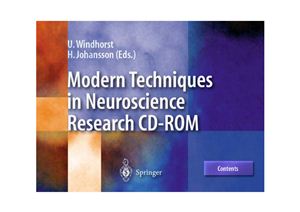Springer, 1999, 1314 pages
Springer Lab Manuals Series: Mode techniques in neuroscience research
This manual provides an overview of the techniques used in mode neuroscience research. The emphasis is on showing how different techniques can optimally be combined in the study of problems that arise at some levels of nervous system organization.
This is essentially a working tool for the scientist in the laboratory and clinic, providing detailed step-by-step protocols with tips and recommendations. Most chapters and protocols are organized such that they can be used independently, while cross-references between the chapters, a glossary, a list of suppliers and appendices provide further help.
It is a working tool for the scientist in the laboratory and clinic, providing detailed step-by-step protocols with tips and recommendations. Most chapters or protocols are organized such that they can be used independently of one another.
Cytological Staining Methods
Application of Differential Display and Serial Analysis of Gene Expression in the Nervous System
Methods Towards Detection of Protein Synthesis in Dendrites and Axons
Optical Recording from Individual Neurons in Culture
Electrical Activity of Individual Neurons In Situ: Extra- and Intracellular Recording
Electrical Activity of Individual Neurons: Patch-Clamp Techniques
Microiontophoresis and Pressure Ejection
An Introduction to the Principles of Neuronal Modelling
In Vitro Preparations
Culturing CNS Neurons: A Practical Approach to Cultured Embryonic Chick Neurons
Neural Stem Cell Isolation, Characterization and Transplantation
In Vitro Reconstruction of Neuronal Circuits: A Simple Model System Approach
Grafting of Peripheral Nerves and Schwann Cells into the CNS to Support Axon Regeneration
Cell and Tissue Transplantation in the Rodent CNS
Histological Staining Methods
Optical Recording from Populations of Neurons in Brain Slices
Recording of Electrical Activity of Neuronal Populations
Time and Frequency Domain Analysis of Spike Train and Time Series Data
Information-Theoretical Analysis of Sensory Information
Information-Theoretical Analysis of Small Neuronal Networks
Linear Systems Description
Nonlinear Analysis of Neuronal Systems
Dynamical Stability Analyses of Coordination Pattes
Detection of Chaos and Fractals from Experimental Time Series
Neural Networks and Modeling of Neuronal Networks
Acquisition, Processing and Analysis of the Surface Electromyogram
Decomposition and Analysis of Intramuscular Electromyographic Signals
Relating Muscle Activity to Movement in Animals
Long-term Cuff Electrode Recordings from Peripheral Nerves in Animals and Humans
Microneurography in Humans
Biomechanical Analysis of Human and Animal Movement
Detection and Classification of Synergies in Multijoint Movement with Applications to Gait Analysis
Magnetic Stimulation of the Nervous System
In-vivo Optical Imaging of Cortical Architecture and Dynamics
Electroencephalography
Mode Techniques in ERP Research
Magnetoencephalography
Magnetic Resonance Imaging of Human Brain Function
Positron Emission Tomography of the Human Brain
Magnetic Resonance Spectroscopy of the Human Brain
Monitoring Chemistry of Brain Microenvironment: Biosensors, Microdialysis and Related Techniques
Invasive Techniques in Humans: Microelectrode Recordings and Microstimulation
Psychophysical Methods
Analysis of Behavior in Laboratory Rodents
Data Acquisition, Processing and Storage
Springer Lab Manuals Series: Mode techniques in neuroscience research
This manual provides an overview of the techniques used in mode neuroscience research. The emphasis is on showing how different techniques can optimally be combined in the study of problems that arise at some levels of nervous system organization.
This is essentially a working tool for the scientist in the laboratory and clinic, providing detailed step-by-step protocols with tips and recommendations. Most chapters and protocols are organized such that they can be used independently, while cross-references between the chapters, a glossary, a list of suppliers and appendices provide further help.
It is a working tool for the scientist in the laboratory and clinic, providing detailed step-by-step protocols with tips and recommendations. Most chapters or protocols are organized such that they can be used independently of one another.
Cytological Staining Methods
Application of Differential Display and Serial Analysis of Gene Expression in the Nervous System
Methods Towards Detection of Protein Synthesis in Dendrites and Axons
Optical Recording from Individual Neurons in Culture
Electrical Activity of Individual Neurons In Situ: Extra- and Intracellular Recording
Electrical Activity of Individual Neurons: Patch-Clamp Techniques
Microiontophoresis and Pressure Ejection
An Introduction to the Principles of Neuronal Modelling
In Vitro Preparations
Culturing CNS Neurons: A Practical Approach to Cultured Embryonic Chick Neurons
Neural Stem Cell Isolation, Characterization and Transplantation
In Vitro Reconstruction of Neuronal Circuits: A Simple Model System Approach
Grafting of Peripheral Nerves and Schwann Cells into the CNS to Support Axon Regeneration
Cell and Tissue Transplantation in the Rodent CNS
Histological Staining Methods
Optical Recording from Populations of Neurons in Brain Slices
Recording of Electrical Activity of Neuronal Populations
Time and Frequency Domain Analysis of Spike Train and Time Series Data
Information-Theoretical Analysis of Sensory Information
Information-Theoretical Analysis of Small Neuronal Networks
Linear Systems Description
Nonlinear Analysis of Neuronal Systems
Dynamical Stability Analyses of Coordination Pattes
Detection of Chaos and Fractals from Experimental Time Series
Neural Networks and Modeling of Neuronal Networks
Acquisition, Processing and Analysis of the Surface Electromyogram
Decomposition and Analysis of Intramuscular Electromyographic Signals
Relating Muscle Activity to Movement in Animals
Long-term Cuff Electrode Recordings from Peripheral Nerves in Animals and Humans
Microneurography in Humans
Biomechanical Analysis of Human and Animal Movement
Detection and Classification of Synergies in Multijoint Movement with Applications to Gait Analysis
Magnetic Stimulation of the Nervous System
In-vivo Optical Imaging of Cortical Architecture and Dynamics
Electroencephalography
Mode Techniques in ERP Research
Magnetoencephalography
Magnetic Resonance Imaging of Human Brain Function
Positron Emission Tomography of the Human Brain
Magnetic Resonance Spectroscopy of the Human Brain
Monitoring Chemistry of Brain Microenvironment: Biosensors, Microdialysis and Related Techniques
Invasive Techniques in Humans: Microelectrode Recordings and Microstimulation
Psychophysical Methods
Analysis of Behavior in Laboratory Rodents
Data Acquisition, Processing and Storage

